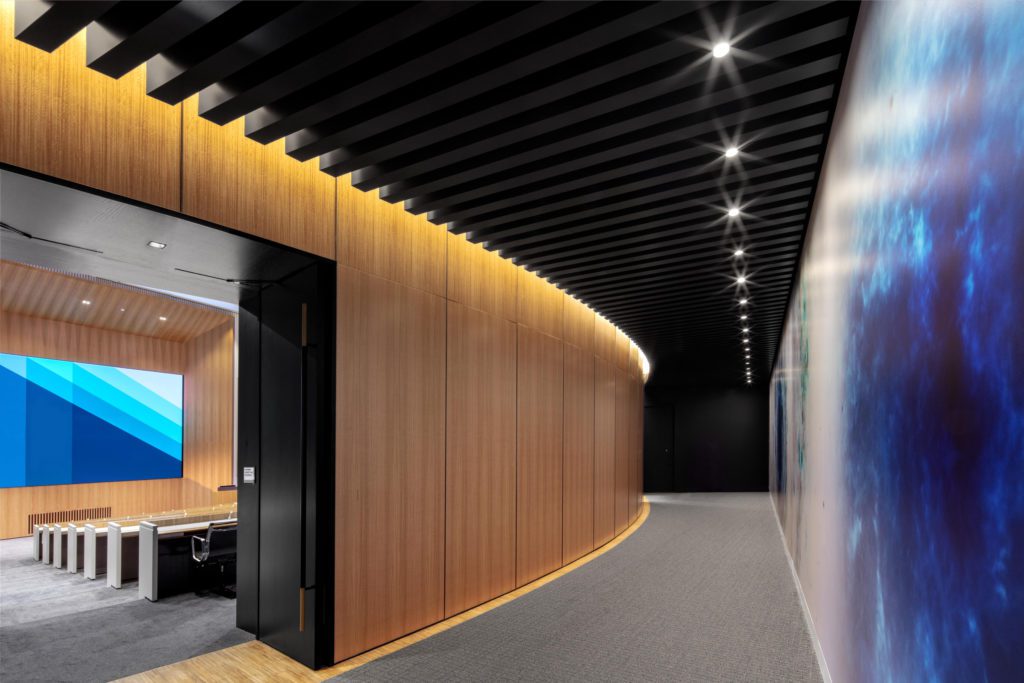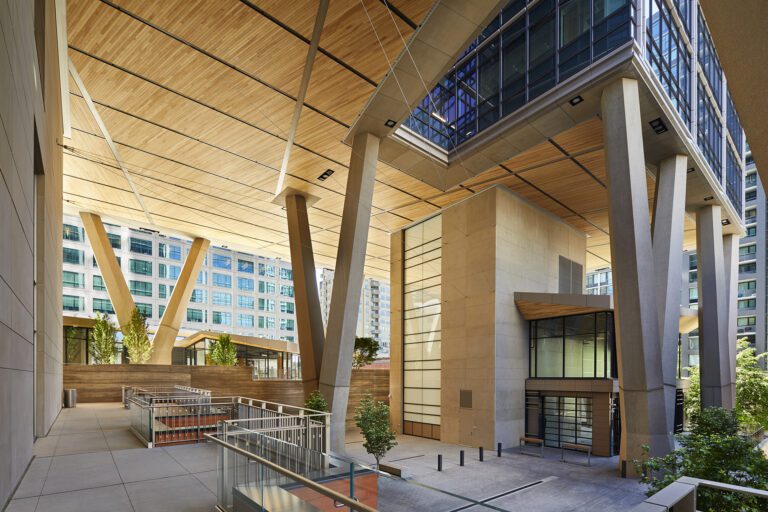Wood ceiling panels range from affordable engineered wood products ($10-$30/sq. ft.) to premium solid hardwoods and mass timber systems ($40-$50/sq. ft.). Budget options offer practical acoustics and basic aesthetics, while high-end systems provide superior sound control (NRC 0.7-0.9), better sustainability credentials, and distinctive design features. The right choice depends on your project’s performance needs, sustainability goals, and visual impact.
How Do Wood Ceiling Panel Options affect Cost and Quality?
When selecting wood ceiling panels for commercial spaces, the price gap between entry-level and premium options often raises questions about value. Is investing in high-end systems worth it, or can affordable alternatives deliver similar performance?
The answer lies in understanding what drives cost differences and how these factors affect project outcomes. Research from the Forest Products Laboratory shows that material composition, manufacturing complexity, acoustic performance, and sustainability credentials all contribute to the final cost and performance of wood ceiling systems.
Commercial architects and designers must balance client budgets against performance requirements. This analysis compares affordable and high-end wood ceiling panels across key metrics to help you make informed decisions for your next project.
What Materials Are Used in Affordable and High-End Wood Ceiling Panels?
Affordable Options: Engineered Efficiency
Affordable wood ceiling panels usually use engineered wood products (EWPs) that maximize resource efficiency. These include:
- Laminated veneer lumber (LVL) panels combining thin wood layers with adhesives
- Oriented strand board (OSB) systems using compressed wood chips and resins
- Agricultural composites incorporating straw-based particleboard
These materials represent important innovations in sustainable building products. USDA research shows straw-based panels can save $1.25-$1.50 per square foot compared to traditional systems while still meeting basic acoustic and aesthetic needs. The Endure™ Linear system shows how engineered materials can deliver durability at accessible prices.
High-End Systems: Premium Materials and Processing
Premium wood ceiling panels use materials chosen for superior performance and visual impact:
- Solid hardwoods like white oak, maple, or exotic species ($40-$50/sq. ft.)
- Cross-laminated timber (CLT) systems with enhanced structural properties
- Acoustic hybrids integrating mineral wool and specialized backing materials
These systems undergo more complex manufacturing. For example, high-end Aluratone panels combine precision-milled hardwoods with acoustic backing to achieve superior sound control. The manufacturing complexity adds to costs but delivers exceptional performance and aesthetics that define signature spaces.
How Does Acoustic Performance Vary Between Budget and Premium Wood Ceiling Panels?
Entry-Level Acoustic Solutions
Affordable wood ceiling panels offer a practical level of sound control well-suited to everyday commercial environments. These systems typically use straightforward design features, such as simple perforations and lightweight backing materials, to manage ambient noise effectively. While they may not offer the advanced performance of high-end systems, they provide an accessible solution for projects where moderate sound control is sufficient.
These panels are a strong fit for general-purpose spaces like offices, classrooms, and retail areas. Their acoustic performance is often adequate to improve speech clarity and reduce unwanted noise, helping create more comfortable and productive environments. For teams working within tight budgets, these solutions strike a thoughtful balance between functionality and cost-efficiency—without compromising core performance.
Premium Acoustic Excellence
High-end wood ceiling systems raise acoustic performance to exceptional levels, achieving NRC ratings of 0.7-0.9 and noise isolation class (NIC) ratings of 55-60. This level is crucial in spaces where acoustic precision matters:
- Concert halls and performance venues
- Executive boardrooms and conference centers
- Healthcare environments requiring speech privacy
- Multi-use spaces with varying acoustic demands
The Curvatone system shows how premium wood panels combine advanced acoustic engineering with distinctive curved forms. Acoustic modeling research indicates these sophisticated systems can reduce reverberation time by up to 50% in open-plan spaces, creating environments where clear communication is a competitive advantage.
What Are the Sustainability Benefits of Affordable vs. High-End Wood Ceiling Systems?
Baseline Sustainability
Entry-level wood ceiling panels meet fundamental environmental requirements:
- CARB Phase 2 compliance for formaldehyde emissions
- Basic FSC Mix certification for responsible forestry
- Standard recycled content percentages
These systems satisfy basic green building standards while staying affordable. EPA guidelines limit formaldehyde emissions to ≤0.05 ppm for composite panels, ensuring even budget-friendly options meet essential health standards. The Select-N-Ship program offers several options balancing basic sustainability with cost efficiency.
Advanced Environmental Performance
Premium wood ceiling systems provide comprehensive sustainability credentials that contribute significantly to green building certifications:
- Carbon sequestration of 0.9-1.1 tons of CO₂/m² in mass timber systems
- Cradle-to-Cradle Gold certification with 95% recyclability
- FSC 100% certification ensuring complete chain of custody
- Zero-VOC finishes and adhesives
These advanced environmental features help projects achieve demanding certifications like LEED Platinum and Living Building Challenge. The sustainability program shows how premium wood ceiling systems support carbon-neutral building strategies through responsible material sourcing and manufacturing.
How Do Design Options and Aesthetics Vary in Wood Ceiling Panels?
Practical Aesthetics
Affordable wood ceiling panels offer functional aesthetics with:
- Standard veneer options in common wood species
- Basic linear and grid patterns
- Limited customization
- Standard finish selections
These systems create warm, inviting spaces with natural materials at accessible prices. The Linear collection shows how budget-conscious projects can incorporate natural wood elements that enhance interiors.
Signature Design Elements
High-end wood ceiling systems serve as architectural focal points through:
- Custom curved and three-dimensional forms
- Exotic wood species with distinctive grain patterns
- Integration with lighting and mechanical systems
- Bespoke finishes and treatments
Premium options like the Cubes ceiling system add depth and visual interest that transform ordinary spaces into memorable environments. The gallery of completed projects showcases how these systems create signature design elements defining commercial spaces’ character.
What Are the Installation Costs and Long-Term Benefits of Different Wood Ceiling Systems?
Installation Considerations
Affordable systems usually feature standardized components designed for efficient installation. Prefabricated EWP systems can reduce labor costs by 20-30% compared to on-site fabrication, making them attractive for projects with tight schedules and budgets.
Premium systems often require specialized installation expertise. The Beams collection shows how high-end elements may involve more complex installation but deliver distinctive architectural features that justify the extra effort.
What Are the Long-Term Benefits and Costs of Different Wood Ceiling Systems?
Several factors favor premium systems when evaluating long-term value:
- Durability: High-end wood ceiling panels typically last 30+ years versus 15-20 years for budget options
- Maintenance: Engineered wood’s resistance to warping cuts maintenance costs by 40% in humid environments
- Energy efficiency: Mass timber’s thermal properties can save 15-20% on energy through better thermal regulation
For projects with long-term ownership, these factors may offset higher initial costs. The Endure™ Direct Attach system shows how premium materials deliver extended performance that justifies higher upfront investment.
How Do You Choose Between Affordable and High-End Wood Ceiling Panels?
When Affordable Systems Make Sense
Budget-friendly options offer excellent value for:
- Projects with tight budgets
- Spaces with basic acoustic needs
- Short-term tenant improvements
- Large-scale applications where volume lowers costs
The Grilles collection provides cost-effective solutions that maintain essential performance while respecting budget limits.
When Premium Systems Deliver Superior Value
High-end wood ceiling panels become worthwhile investments for:
- Signature spaces where design impact drives business value
- Environments with demanding acoustic needs
- Projects seeking advanced sustainability certifications
- Buildings with long-term ownership
Systems like Curvalon deliver exceptional performance and distinctive aesthetics that define memorable commercial environments.
How Can You Balance Cost and Quality in Wood Ceiling Panel Selection?
The range between affordable and high-end wood ceiling panels offers many points where cost and performance match project needs. By understanding the benefits each tier provides, you can make informed choices that maximize value without overspending.
For help selecting the best wood ceiling system for your project, the Flat Veneer Panels collection offers versatile options across price points. The Baffles collection also provides acoustic solutions from affordable to premium.
To discuss your project and explore custom options balancing performance with budget, contact our team for personalized recommendations based on your unique needs.




